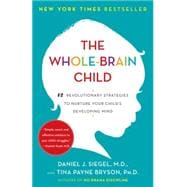
Note: Supplemental materials are not guaranteed with Rental or Used book purchases.
Purchase Benefits
Looking to rent a book? Rent The Whole-Brain Child 12 Revolutionary Strategies to Nurture Your Child's Developing Mind [ISBN: 9780553386691] for the semester, quarter, and short term or search our site for other textbooks by Siegel, Daniel J.; Bryson, Tina Payne. Renting a textbook can save you up to 90% from the cost of buying.
Daniel J. Siegel, M.D., is clinical professor of psychiatry at the UCLA School of Medicine, the founding co-director of the UCLA Mindful Awareness Research Center, and executive director of the Mindsight Institute. A graduate of Harvard Medical School, Dr. Siegel is the author of several books, including the New York Times bestsellers Brainstorm, Mind, and, with Tina Payne Bryson, The Whole-Brain Child and No-Drama Discipline. He is also the author of the bestsellers Mindsight and, with Mary Hartzell, Parenting from the Inside Out. He lives in Los Angeles with his wife, with welcome visits from their adult son and daughter.
Tina Payne Bryson, Ph.D., is a pediatric and adolescent psychotherapist, parenting consultant, and the director of parenting education and development for the Mindsight Institute. A frequent lecturer to parents, educators, and professionals, she lives near Los Angeles with her husband and three children.
| Introduction: Survive Andihrne | p. vii |
| Parenting with the Brain in Mind | p. 3 |
| Two Brains are Better than One: Integrating the Left and the Right | p. 14 |
| Whole-Brain Strategy #1: Connect and Redirect: Surfing Emotional Waves | |
| Whole-Brain Strategy #2: Name It to Tame It: Telling Stories to Calm Big Emotions | |
| Building the Staircase of the Mind: Integrating the Upstairs and Downstairs Brain | p. 37 |
| Whole-Brain Strategy #3: Engage, Don't Enrage: Appealing to the Upstairs Brain | |
| Whole-Brain Strategy #4: Use It or Lose It: Exercising the Upstairs Brain | |
| Whole-Brain Strategy #5: Move It or Lose It: Moving the Body to Avoid Losing the Mind | |
| Kill the Butterflies! Integrating Memory for Growth and Healing | p. 66 |
| Whole-Brain Strategy #6: Use the Remote of the Mind: Replaying Memories | |
| Whole-Brain Strategy #7: Remember to Remember: Making Recollection a Part of Your Family's Daily Life | |
| The United States of Me: Integrating the Many Parts of the Self | p. 92 |
| Whole-Brain Strategy #8: Let the Clouds of Emotion Roll By: Teaching That Feelings Come and Go | |
| Whole-Brain Strategy #9: SIFT: Paying Attention to What's Going On Inside | |
| Whole-Brain Strategy #10: Exercise Mindsight: Getting Back to the Hub | |
| The Me-We Connection: Integrating Self and Other | p. 119 |
| Whole-Brain Strategy #11: Increase the Family Fun Factor: Making a Point to Enjoy Each Other | |
| Whole-Brain Strategy #12: Connect Through Conflict: Teach Kids to Argue with a "We" in Mind | |
| Conclusion: Bringing it All Together | p. 145 |
| Refrigerator Sheet | p. 151 |
| Whole-Brain Ages and Stages | p. 153 |
| Acknowledgments | p. 169 |
| Index | p. 173 |
| Table of Contents provided by Ingram. All Rights Reserved. |
The New copy of this book will include any supplemental materials advertised. Please check the title of the book to determine if it should include any access cards, study guides, lab manuals, CDs, etc.
The Used, Rental and eBook copies of this book are not guaranteed to include any supplemental materials. Typically, only the book itself is included. This is true even if the title states it includes any access cards, study guides, lab manuals, CDs, etc.